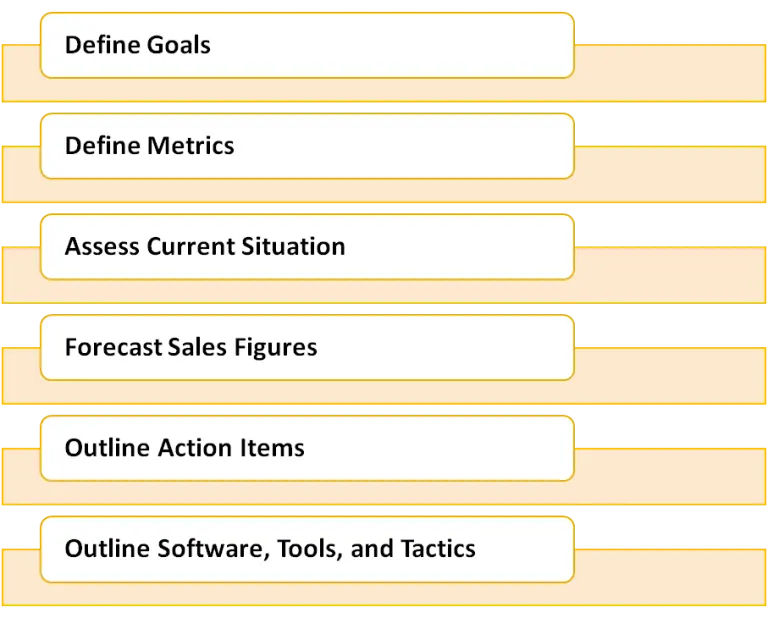Are you planning on starting a business but have skipped the crucial step of creating a sales plan? Or have you recently realized the importance of creating a sales plan and are looking for guidance? Well, you aren’t the only one. According to a study, business organizations with well-designed sales plans have achieved at least 27% of higher revenue growth in comparison to organizations without formal plans. That’s a figure that will help you in realizing the importance of having a well-designed plan in place. In this article, we will provide you with detailed guidance on creating an effective sales plan that can drive your business toward growth and success.
What is a Sales Plan?
Peter Drucker, a famous business magnate, and industrialist, once said, “Plans are only good intentions unless they immediately degenerate into hard work.” This quote beautifully expresses the essence of the planning process. When it comes to building a business, a sales plan is like a well-guided roadmap that guides your actions and efforts to achieve business objectives and sales targets. Imagine you are planning on opening a small bakery. Your sales plan should outline strategies and ideas to identify target customers, attract the target customers, and mark sales goals. In simple words, a sales plan is a comprehensive document that highlights specific tactics, steps, and resources required to drive sales and revenue of the business organisation. It also helps you stay proactive, organized, and focused in pursuing your sales goal.
Components to Consider While Creating a Sales Plan
Now that you know what sales plan is, let’s read about the components of a sales plan:

- Target Audience: For every business organization finding the right audience to sell to is very important. By understanding who they are and what they need, you can focus more on the strategies and efforts to be more successful. For example, Let’s say a newly launched software company can target small and medium-sized business organizations (SMBs) in the retail industry that are looking for user-friendly and cost-effective sales software to streamline their operations and manage inventories effectively.
- Revenue Target: You need to set goals on how much finance you would want to make in a specific time frame, like a monthly or in a quarter. This component will give you a direction or motivation to work following them. It should be framed about business goals, market trends, and sales goals. For example, The sales team of “XXXXXXX” set a monthly revenue target of ₹50,000, aiming for at least 15% revenue growth in comparison to the previous month.
- Sales Tactics and Strategies: This competency focuses on figuring out ideal strategies to approach potential customers and satisfy their needs. It helps generate more leads to convert them into sales and inviting money. It is more of a secret weapon that, when determined and executed properly, can help you dominate the market. For example, The sales team of “XXXXXX” thought of implementing a cross-selling technique by offering complementary gifts to customers who would purchase items with a specific amount. This tactic will not increase the order value but also enhances the customer’s shopping experience.
- Promotional Tactics: Promotional tactics are different methods to promote your products or services to encourage the target audience to buy products and generate desired revenue and interest. It can be done through social media campaigns, advertisements, and collaborating with famous influencers. Effective promotion tag text helps business organisations in increasing their brand visibility, drive sales, and attract leads. For example, a company known as “XXXXXX” runs a social media campaign to promote their new line of organic drinks. They collaborated with fitness and health influences to create engaging health content with discount codes, driving both sales and brand awareness.
- Pricing: This component decides how much price a business organization will charge for its products and services. It is also important to set pricing that matches their customer’s willingness to pay and is better than their competitors. By seeing the price right, you can sell more and more by generating desirable revenue and finding a place for yourself in the market. For example: “XXXXXXX” implemented a value-based pricing strategy for their e-books by offering premium titles at a higher price by providing exclusive content and recommendation. This strategy emphasized the value of their product.
- Team Structure: This component emphasizes organizing the sales team in a manner that everyone knows their roles and responsibilities. It helps organisations in working together along with the optimum utilization of resources. This component is the backbone of the plan as it lists the skills, roles, and responsibilities of employees that will drive the organization towards its goals. For example, an organization called “XXXXXXXXX” appointed a sales manager to supervise a team of regional sales operation managers or sales representatives to manage and track sales along with handling incoming inquiries and concerns related to sales.
- Deadlines: This may not be the exciting part of the sales plan. This component determines setting a specific time to complete tasks or to reach sales goals. It keeps the organization accountable and focused on making progress and making related progress. It can be done by breaking your goals into manageable tasks to attain sales and revenue. For example, the sales team of “xxxxxxxx” sets a deadline of three weeks to attain sales and revenue.
Steps To Create a Sales Plan
Now that you know the 7 components of sales plans, let’s learn about the steps to create a well-designed and easy-to-implement sales plan.

- Define Goals
• Set specific, measurable, actionable, relevant, and time-bound, a.k.a SMART approach.
• Consider the market conditions, team’s capabilities, and budget while setting your sales goal.
• Make sure that each component of your sales plan aligns with your overall goal. - Define Metrics
• Identify KEY PERFORMANCE INDICATORS (KPIs) that will help you measure success.
• Choose metrics that are relevant to your business organization, such as conversion rates, total sales, sales cycle length, LTV, and CAC.
• Ensure the metrics are measurable, easy to track, and realistic while using call monitoring software and CRM.
• Set specific targets for each metric following your goals. - Assess Current Situation
• Analyze your competitor’s sales strategies to create your sales goals and opportunity
• Evaluate your sales team’s performance, training needs, target achievement, and team composition.
• Review your sales data from previous years, including acquisition costs, conversion rates, and revenue. - Forecast Sales Figures
• Estimate your future sales revenue based on market trends, historical data, and sales goals.
• Consider factors like marketing campaigns, upcoming product launches, or economic conditions.
• Break down your revenue targets into manageable sections, growth rates, and seasonal fluctuations. - Outline Action Items
• Identify specific resources and technology that will help your organization in achieving sales targets.
• Keep action items achievable, realistic, and focused on the most impactful tasks.
• Update and review action items regularly to make sure the organization drives toward success. - Outline Software, Tools & Tactics
• Identify and research suitable tools and software to support your sales strategy.
• Consider CRM software, call tracking software, lead generation tools, sales automation tools, and email marketing software.
• Determine the strategies that will employ, such as inbound marketing strategies (social media and content marketing) or outbound marketing strategies (email outreach and cold calling).
• Outline how these tools, tactics, and software will be integrated into your sales plan and strategy.
Remember to adapt these steps to create sales plans according to your business needs and goals. Make sure to review and update your sales plan as necessary regularly.
Closecall for Boost in Sales
Closecall is an intelligent call management system that ensures a boost in sales for organizations that use it. Integrate it into the phone of your calling agents and analyze their performance graph. The real-time call tracking increases the productivity of the employees, and employers can find out the loopholes in the work of their employees and transform them accordingly. Modern-day businesses are increasing their business efficiency using Closecall.
The Final Words on Creating a Sales Plan
Having a well-designed sales plan is vital for every business organization aiming to achieve growth and profitability. It acts as a compass, helping navigate through the uncertainties and challenges of the business world. Sales also play a vital role in generating revenue for the business, which is why which is by having a careful plant sales plan is necessary to attract customers and satisfy their needs. Throughout this article, we have provided you with detailed and easy-to-implement strategies for creating a comprehensive sales plan that will drive your business toward achieving its sales objectives and overall success. By following these steps and incorporating the components or steps to create a sales plan, you will be equipped with powerful tools to boost revenue, drive sales, and thrive in the competitive market. Also, if you are looking for ways to boost your business sales, install Closecall app in the mobile phone of your employees.
Read our Article: 12 Strategies for Convincing Customers to Buy From You on a Call



